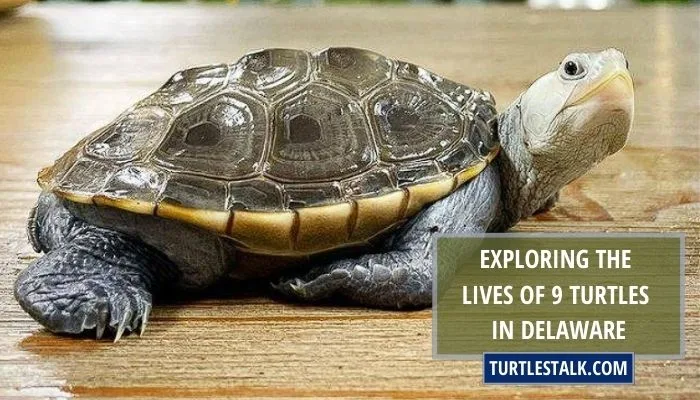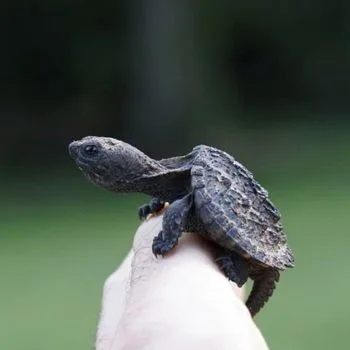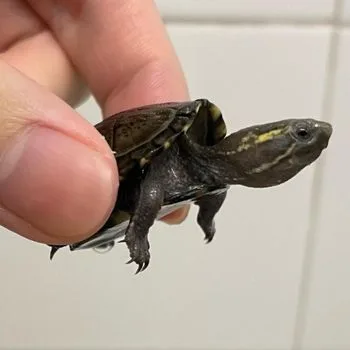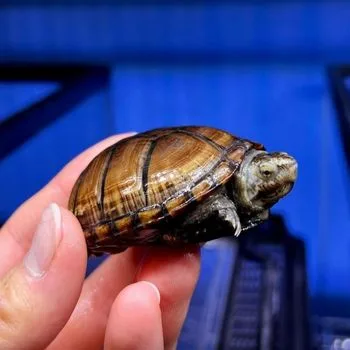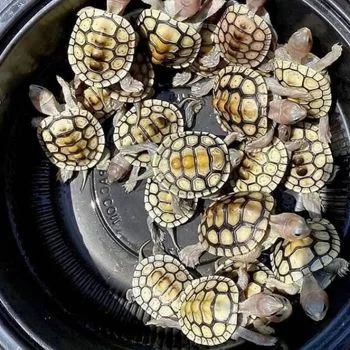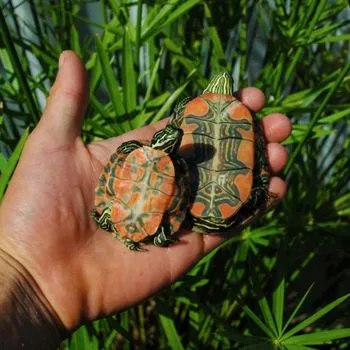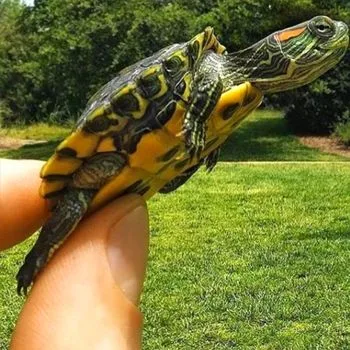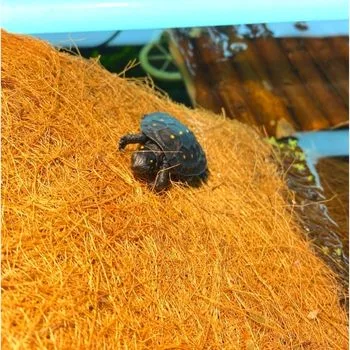Exploring the Lives of 9 Turtles in Delaware
Welcome to Delaware, where the waters are teeming with one of nature’s most fascinating creatures: turtles! The state is home to a wide variety of freshwater turtles, including the Eastern Painted Turtle, Midland Painted Turtle, Pond Slider, Eastern Snapping Turtle and Wood Turtle.
These aquatic reptiles have been captivating people for centuries—from Native Americans who used them as food sources to modern-day researchers who study their behavior in the wild.
With its abundance of lakes and rivers, Delaware provides an ideal habitat for these incredible animals. Let’s take a closer look at nine of these remarkable creatures and explore why they call this state home.
| # | Name | Details | Image |
| 1 | Common Snapping Turtle (Chelydra serpentina) |
| 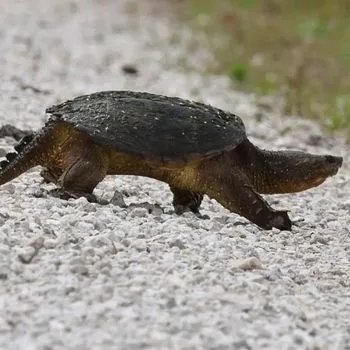 |
| 2 | Common Musk Turtle (Sternotherus Odoratus) |
| 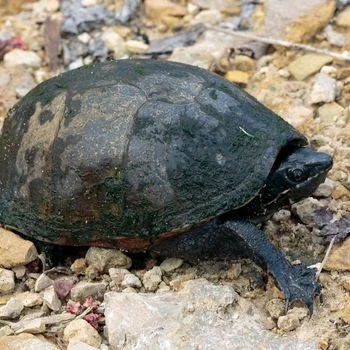 |
| 3 | Eastern Mud Turtle (Kinosternon Subrubrum) |
| 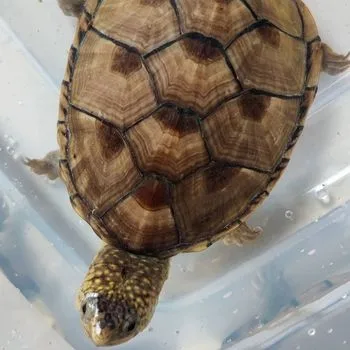 |
| 4 | Eastern Box Turtle (Terrapene Carolina) |
| 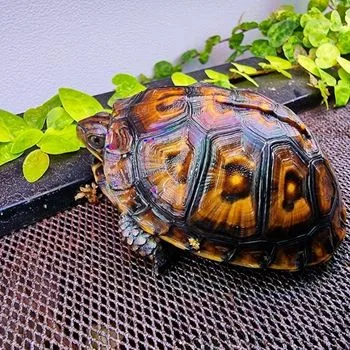 |
| 5 | Eastern Painted Turtle (Chrysemys Picta) |
| 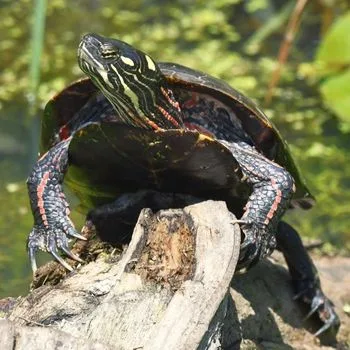 |
| 6 | Northern Red-Bellied Cooter (Pseudemys Rubriventris) |
| 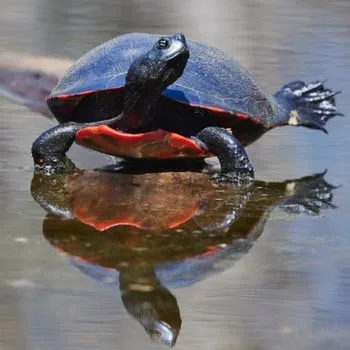 |
| 7 | Northern Diamondback Terrapin (Malaclemys terrapin terrapin) |
| 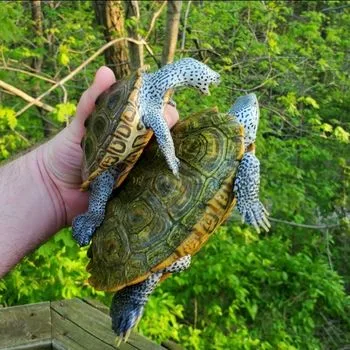 |
| 8 | Red Eared Slider (Trachemys Scripta Elegans) |
| 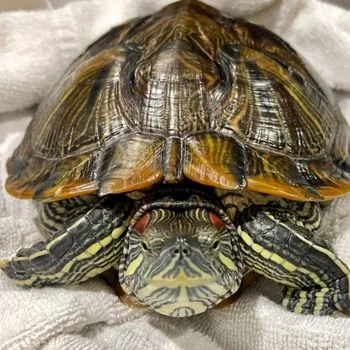 |
| 9 | Spotted Turtle (Clemmys Guttata) |
| 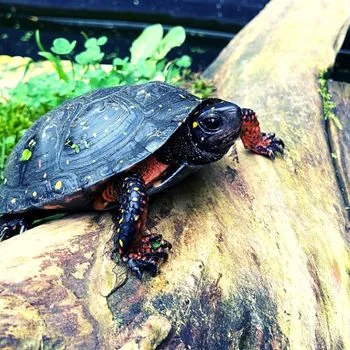 |
9 Turtles You Can Find in Delaware
In total, there are 9 species of turtles in the state of Delaware. This guide will take you on an exploration through each turtle type and provide tips for providing them with proper care. So, let’s get started on our journey into discovering all the wonders that these reptiles have to offer!
1. Common Snapping Turtle (Chelydra serpentina)
- Family: Chelydridae
- Genus: Chelydra
- Type: Freshwater turtle
- Natural Habitat: Freshwater habitats such as lakes, rivers, and swamps
- Lifespan: 50 years
- Maximum Size: 19 inches
- Maximum Weight: 40 pounds
- Prone to Diseases: Fungal infections and shell rot
- Aggression Level: Not aggressive until provoked
- Predators: River otters, bears and coyotes
- Domestication: Not recommended as pets
The Common Snapping Turtle, scientifically known as Chelydra serpentina, is an aquatic species native to freshwater habitats such as lakes, rivers and swamps. These turtles are highly adaptable and can live up to 50 years in the wild.
Adult Common Snapping Turtles typically measure 10-16 inches in shell length but can grow up to 19 inches and weigh around 40 pounds. They have a powerful bite with an estimated pressure of over 600 psi, making them one of the strongest biters among reptiles. Despite their strength they are generally not aggressive animals, though it is best to not provoke them and take caution around them.
Common Snapping Turtles often face threats from predators such as river otters, bears and coyotes when living out in the wild.
Unfortunately, their habitat is also threatened by human activities such as development and pollution which can lead to a decrease in population numbers if conservation efforts are not taken soon here in Delaware.
Although they make fascinating pets due to their long lifespan of up to 50 years when cared for properly, some states have regulations or restrictions on owning them so check with local authorities before acquiring this species as a pet.
These turtles have webbed feet for swimming and a long tail for propulsion allowing them to move quickly through water which also makes them difficult prey for predators.
Furthermore, although they occupy multiple states across North America from Alabama to Wyoming there is no other name than the Common Snapping Turtle so it’s easy to identify.
It should be noted that this species does not carry any significant disease that can be transmitted to humans yet they may still be prone to diseases like fungal infections or shell rot when kept in unsanitary conditions so proper care must be taken here in Delaware when considering owning one of these remarkable creatures as a pet.
2. Common Musk Turtle (Sternotherus Odoratus)
- Family: Kinosternidae
- Genus: Sternotherus
- Type: Terrestrial and aquatic turtle
- Natural Habitat: Streams, rivers, ponds, and swamps in eastern north america
- Lifespan: 10-20 years
- Also Known As: Stinkpot
- Maximum Size: 4-8 inches
- Maximum Weight: 0.7 pounds
- Prone to Diseases: Respiratory infections and shell rot
- Aggression Level: Agressive but not known to bite humans
- Predators: Raccoons, mink, birds of prey, and large fish
- Domestication: Can be kept as pets
The Common Musk Turtle (Sternotherus Odoratus) is a terrestrial and aquatic turtle found in streams, rivers, ponds, and swamps throughout the eastern United States. This species can reach an impressive length of 4-8 inches when fully grown, with an average weight of 0.7 pounds. Interestingly, these turtles are also known as ‘Stinkpots’ due to their ability to secrete a musky odour when alarmed or threatened.
Their flat carapace makes them well adapted for life in the water, with strong webbed feet and sharp claws helping them cling onto rocks or vegetation while searching for food. As omnivores they feed on snails, clams and other insects as well as plant matter such as algae and leaves – making them a vital part of the local ecosystem here in Delaware. They are generally non-aggressive but may bite if disturbed or threatened by predators such as river otters, raccoons, mink and birds of prey.
The Common Musk Turtle is not currently listed as an endangered species but habitat loss due to human activities such as development and pollution can lead to a decrease in population numbers – especially without proper conservation efforts. Additionally, illegal pet trade can be an issue that affects their vulnerability so it’s important to check local regulations before acquiring this species as a pet.
Despite all this however, with proper care these turtles have been known to live up to 20 years making them great companions for experienced keepers who are willing to put in the effort necessary for their special care needs here in Delaware.
3. Eastern Mud Turtle (Kinosternon Subrubrum)
- Family: Kinosternidae
- Genus: Kinosternon
- Type: Mud turtle
- Natural Habitat: Freshwater wetlands, swamps, and slow-moving streams
- Lifespan: 30 years
- Maximum Size: 5 inches
- Maximum Weight: 9.27 ounces
- Aggression Level: Low
- Predators: Raccoons, snakes, and birds of prey
- Domestication: Not suitable as a pet
The Eastern Mud Turtle (Kinosternon subrubrum) is a small freshwater turtle found in the southeastern United States, including Delaware. This species of turtle is known for its highly aquatic adaptations and webbed feet, which make it well-suited to life in slow-moving streams, swamps, and wetlands. The Eastern Mud Turtle can reach up to 5 inches in length and has a maximum weight of 9.27 ounces. It is not aggressive, but may bite if provoked—so exercise caution when near any wild turtles!
The diet of the Eastern Mud Turtle consists primarily of aquatic invertebrates such as snails, worms, and insects. They are also opportunistic scavengers, meaning they will take advantage of carrion when available. Predators of this species include raccoons, snakes, and birds of prey. The lifespan of these turtles is up to 30 years in the wild and due to their abundance across the southeastern United States are not listed as threatened or endangered.
Although they do not make suitable pets due to their size and temperament being unsuitable for captivity, taking care to observe local wildlife regulations is important when interacting with wild Eastern Mud Turtles in Delaware . Taking steps such as preserving their natural habitats helps protect this species from destruction or poaching—ensuring they remain an iconic part of our environment for many more years to come!
4. Eastern Box Turtle (Terrapene Carolina)
- Family: Emydidae
- Genus: Terrapene
- Type: Terrestrial turtle
- Natural Habitat: Deciduous and mixed forests, meadows, and fields
- Lifespan: 60 years
- Also Known As: Eastern terrapin
- Maximum Size: 4-10 inches
- Maximum Weight: Male: 1 pounds, females: 2 pounds
- Prone to Diseases: Respiratory infections, shell rot, and other diseases
- Aggression Level: Not aggressive towards humans
- Predators: Raccoons, skunks, opossums, and snakes
- Domestication: Can be kept as pets
The Eastern Box Turtle (Terrapene Carolina) is one of the most intriguing species found in deciduous and mixed forests, meadows, and fields of eastern North America. This incredible turtle can live up to 40 years in the wild or even reach up to 60 years in captivity! With adult sizes ranging from 4-10 inches, males being slightly smaller than females with a weight of 0.5-1 lb for males and 1-2 lbs for females.
Eastern Box Turtles are not too aggressive towards humans but potential predators may include raccoons, skunks, opossums, and snakes. They can be kept as pets but it is important to consult local laws before doing so since some states make it illegal to collect wild turtles or sell them as pets—including Delaware. Captive Eastern Box Turtles may be prone to respiratory infections, shell rot, and other diseases common to captive turtles.
This species is state-protected in several states due to the declining population caused by habitat loss and illegal collection for the pet trade. Despite this precarious situation, Eastern Box Turtles can still be found in eastern North America—including Delaware. It is essential that we take steps to protect this species which calls Delaware home by preserving their natural habitats as well as improving public awareness of their plight!
5. Eastern Painted Turtle (Chrysemys Picta)
- Family: Emydidae
- Genus: Chrysemys
- Type: Freshwater turtle
- Natural Habitat: Ponds, streams, lakes, and other aquatic habitats in eastern north america
- Lifespan: 40 years
- Maximum Size: 7-10 inches
- Maximum Weight: 21 ounces
- Prone to Diseases: Respiratory infections, shell rot, and other diseases
- Aggression Level: Not aggressive towards humans
- Predators: Foxes, raccoons, skunks, otters, and birds of prey
- Domestication: Can be kept as pets
The Eastern Painted Turtle (Chrysemys picta) is one of the most beautiful freshwater turtles found in the eastern United States, including states such as Illinois, Indiana, Ohio, Pennsylvania, New York, New Jersey, Connecticut, Rhode Island, Massachusetts, New Hampshire, Vermont, Maine, Delaware, Maryland and Virginia. With their brightly coloured shells and striking markings adorning their bodies this species is certainly a sight to behold.
The Eastern Painted Turtle can reach a length of 7-10 inches with males usually smaller than females. They have a streamlined body and webbed feet which allow them to move through the water with ease making them perfectly adapted for life in aquatic habitats like ponds, streams and lakes. In the wild they can live up to 40 years but with proper care and diet they can live up to 20-30 years in captivity; making them an ideal pet option if you’re looking for a long term companion in Delaware.
These unique little creatures are definitely worth protecting here in Delaware so by taking steps towards preserving their natural habitats we can help ensure that these vibrant animals remain part of our environment for many years to come!
6. Northern Red-Bellied Cooter (Pseudemys Rubriventris)
- Family: Emydidae
- Genus: Pseudemys
- Type: Aquatic turtle
- Natural Habitat: Rivers, swamps, and large ponds in the eastern united states
- Lifespan: Can live up to 50 years
- Also Known As: Cooters
- Maximum Size: 10 to 13.5 inches
- Maximum Weight: 12+ pounds
- Prone to Diseases: Mucinous melanophoroma
- Aggression Level: Not aggressive
- Predators: Raccoons, humans
- Domestication: Can be kept as pet
This one is an aquatic turtle native to rivers, swamps, and large ponds in the eastern United States. They reach an average length of 8 to 11 inches with adult males being slightly smaller than females.
These turtles may be kept as pets but require a large aquarium due to their size. Despite their small appearance they are not regarded as aggressive animals so there’s no need for fear if you come across one near Delaware, simply observe from a respectable distance!
Of course taking them home without permits or licenses is highly illegal – something I’m sure any red-blooded American would know already!
7. Northern Diamondback Terrapin (Malaclemys terrapin terrapin)
- Family: Emydidae
- Genus: Malaclemys
- Type: Aquatic turtle
- Natural Habitat: Salt marshes, brackish water, estuaries, lagoons and tidal creeks along the coast
- Lifespan: 25 – 40 years
- Maximum Size: Males: 4 – 5.5 inches, females: 6 – 9 inches
- Maximum Weight: Males: 0.5 pounds, females: 1.5 pounds
- Prone to Diseases: Shell rot
- Aggression Level: Not aggressive
- Predators: Skunks, raccoons, and foxes
- Domestication: Can be kept as pets if purchased from a licensed captive turtle breeder
The Northern Diamondback Terrapin (Malaclemys terrapin terrapin) is an aquatic turtle native to the US coastal regions, ranging from Massachusetts to Florida and Louisiana to Texas. With an average lifespan of 15-20 years, these reptiles grow up to 18-23 cm in length for females and 12-15 cm for males, although weight information is not specified. Despite their small size, they are excellent swimmers and well adapted to live in brackish water environments like salt marshes or tidal creeks.
Although Northern Diamondback Terrapins are not aggressive towards humans or other animals, they may be preyed upon by raccoons, foxes, crows, gulls and skunks. Furthermore, overcollection for the pet trade has led to population decline in certain areas – resulting in their protected status in some states. As such it may be illegal to keep one as a pet without a permit.
These turtles aren’t picky eaters; they feed on both plant matter such as lettuce as well as animal proteins like insects or crayfish. So if you encounter one of these majestic creatures near Delaware, take the time to appreciate them from a respectful distance!
8. Red Eared Slider (Trachemys Scripta Elegans)
- Family: Emydidae
- Genus: Trachemys
- Type: Aquatic turtle
- Natural Habitat: Streams, rivers, ponds, lakes, swamps, and marshes
- Lifespan: 20 – 30 years
- Also Known As: Red-eared terrapin
- Maximum Size: 7 – 12 inches, females get larger than 12 inches
- Maximum Weight: 3 – 6 pounds
- Prone to Diseases: Respiratory infections, shell rot, and other diseases if kept in unsanitary conditions.
- Disease Carrier: Salmonella
- Aggression Level: Not aggressive
- Predators: Raccoons, otters, fish, frogs, snakes, skunks and birds
- Domestication: Can be kept as pets
The Red Eared Slider (Trachemys scripta elegans) is a freshwater reptile with a striking appearance. Found in Delaware’s waterways, these turtles can reach up to 10-12 inches long as adults and can live for an impressive 30 years. They have webbed feet that are adapted for swimming, making them incredibly agile aquatic creatures.
Males and females exhibit different size ranges, with males being more diminutive compared to the females and juveniles measuring only 2-3 inches when fully grown. Although they may take on aggressive postures if threatened, their bite force is not enough to cause any damage to humans or other larger animals.
It’s important that we respect the habitats of these amazing reptiles so that future generations will be able to enjoy them too – keep their environments clean by disposing of garbage properly and avoid disturbing the fragile ecosystems where they make their homes!
9. Spotted Turtle (Clemmys Guttata)
- Family: Emydinae rafinesque
- Genus: Clemmys
- Type: Semi-aquatic turtle
- Natural Habitat: Marshy meadows, ponds, ditches, bogs, swamps, etc. as small bodies of still water.
- Lifespan: 60 – 100+ years
- Maximum Size: 4 – 5 inches
- Maximum Weight: 0.5 to 1 pound
- Prone to Diseases: Vitamin a deficiency, respiratory diseases, abscesses, shell infections and fractures, and parasites
- Disease Carrier: Salmonella
- Aggression Level: Coexisting is possible for spotted turtles, but housing male individuals together may lead to aggression.
- Predators: Mammals, such as raccoons, muskrats, birds and large fishes.
- Domestication: Can be kept as pets
Introducing the Spotted Turtle (Clemmys Guttata)! This small, terrestrial and aquatic turtle is native to the eastern United States from Maine down to Delaware. Adults grow up to 4-5 inches in carapace length, with a weight ranging between half a pound and one pound. Juveniles can measure between 1-3 inches when they hatch.
These animals are quite hardy creatures who generally live peaceably amongst their own kind; however, under threat they may become somewhat aggressive. There are several predators that hunt them such as raccoons, skunks, snakes and birds of prey in this area.
Despite being only mildly domesticated creatures it is possible for these turtles to be kept as pets with specialized care. Prone illnesses include respiratory infections and shell rot – but fortunately this species does not act as a disease carrier itself!
Final Words
In the state of Delaware—a place rich in biodiversity—turtles play a significant role; with a variety of species dwelling in its forests, beaches, and rivers.
In this article, we took a closer look at these fascinating creatures (including their natural habitats, lifespan, size and weight, predators, and domesticability). It’s worth noting that, while keeping these turtles as pets is legal; their populations in Delaware may be declining due to habitat loss and collection for the pet trade.
It is our responsibility to ensure that these turtles remain protected and preserved for future generations to enjoy in the state of Delaware.
Other Nearby States:

